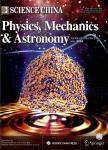Exchange bias for ferromagnetic/antiferromagnetic bilayers with the uniaxial anisotropy being misaligned with the exchange anisotropy
Exchange bias for ferromagnetic/antiferromagnetic bilayers with the uniaxial anisotropy being misaligned with the exchange anisotropy作者机构:College of Physical Science and Technology Inner Mongolia University Hohhot China Key Laboratory of Physics and Chemistry of Functional Materials College of Physics and Electronic Information Inner Mongolia Normal University Hohhot China
出 版 物:《Science China(Physics,Mechanics & Astronomy)》 (中国科学:物理学、力学、天文学(英文版))
年 卷 期:2009年第52卷第12期
页 面:1885-1892页
核心收录:
学科分类:0809[工学-电子科学与技术(可授工学、理学学位)] 07[理学] 070205[理学-凝聚态物理] 08[工学] 0805[工学-材料科学与工程(可授工学、理学学位)] 080502[工学-材料学] 0702[理学-物理学]
基 金:Supported by the National Natural Science Foundation of China (Grant No. 10762001) the Program for New Century Excellent Talents in University of China (Grant No. NCET- 05- 0272) the Specialized Research Fund for the Doctoral Program of Higher Education of China (Grant No. 200801260003 )
主 题:monostable state bistable state intrinstic easy axis intrinstic hard axis switching field
摘 要:Using the principle of minimal energy and S-W model,the exchange bias for ferromagnetic/antiferro-magnetic bilayers has been investigated when the uniaxial anisotropy is misaligned with the exchange anisotropy. According to the relation between the energy of the bilayer and the orientation of ferro-magnetic magnetization,it is found that the bilayer will be in the monostable state or bistable state when the external field is absent in the initial magnetization state. The monostable state or bistable state of the bilayer,which determines the angular dependence of exchange bias directly,is controlled by the competition between the exchange anisotropy and uniaxial anisotropy. When the applied field is parallel to the intrinsic easy axes and intrinsic hard axes,one of the switching fields of the hysteresis loop shows an abrupt change,while the other keep continuous by analyzing the magnetization reversal processes. Consequently,the exchange bias field and the coercivity will show a jump phenomenon. The numerical calculations indicate that both the magnitude and direction of the exchange anisotropy will significantly affect the angular dependence of exchange bias. The jump phenomenon of exchange bias is an intrinsic property of the bilayer,which is dependent on the interfacial exchange-coupling constant,the orientation of the exchange anisotropy,the thickness and uniaxial anisotropy constant of the ferromagnetic layer.



